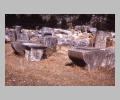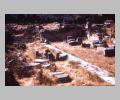
TO DO ??? unsure of bldg and caption, Epidauros, Auxiliary Buildings

TO DO ??? unsure of bldg and caption, Epidauros, Auxiliary Buildings

TO DO. Unknown remains, need correct bldg and caption ???, Epidauros, Auxi...
| Summary: | Sanctuary of Apollo and Asklepios and an Asklepieion or healing center. |
| Type: | Sanctuary |
| Region: | Argolid |
Periods:
Dark Age
Geometric
Archaic
Classical
Hellenistic
Roman
Physical:
On the E coast of the Argolid, the health spa and religious center at Epidauros maintained a bath, hotels and dwellings for the priest-physicians as well as a tholos building, temples, stoas, gymnasium, palaestra, stadium and a theater. The theater is one of the best preserved ancient structures in Greece and is now used for modern presentations of ancient Greek drama. The Asklepieia (athletic and dramatic festival) was held every 4 years. Epidauros is claimed as the birthplace of Asklepios and it was the most celebrated center of his cult.
Description:
Traditionally the region of Epidauros is said to have first been inhabited by the Carians. There existed, in Archaic or earlier times, a cult of Malos in the region, but the establishment of a sanctuary to Apollo and Asklepios is not older than the 6th century B.C. It appears that the sanctuary was first dedicated to Apollo and that only in the 5th century B.C. did Apollo's son Asklepios gain prominence.
At the end of the 5th century B.C. and throughout the 4th century the Asklepieion grew in fame and influence. Every 4 years (9 days after the Isthmian Games) the Panhellenic Asklepieia Games were held. At ca. 380 B.C. poetry and music contests were added to the competition. During the 4th century the cult of Asklepios spread throughout the Greek world. Epidauros was claimed as the birthplace of Asklepios and more than 200 new Asklepieia were built (most notably at Athens, Kos, and Pergamon). Also at this time the previously unadorned sanctuary at Epidauros was filled with votive offerings and monuments. Fame and prosperity continued throughout the Hellenistic period.
In 87 B.C. the sanctuary at Epidauros was looted by Sulla and in 67 B.C. it was plundered by pirates. In the 2nd century A.D. the sanctuary enjoyed a new upsurge under the Romans and the worship of new gods from the East was introduced into the sanctuary. In 395 A.D. the Goths raided the sanctuary. Although the cults of the ancient gods died out under Christianity, the sanctuary at Epidauros was known as late as the mid 5th century A.D. as a Christian healing center.
Exploration:
Excavations: P. Kavvadias and V. Stais of the Greek Archaeological Society began in 1881, the French School of Archaeology for a short time just after W.W. II, and J. Papadimitriou in 1948-51.
Sources Used:
Other Bibliography:


